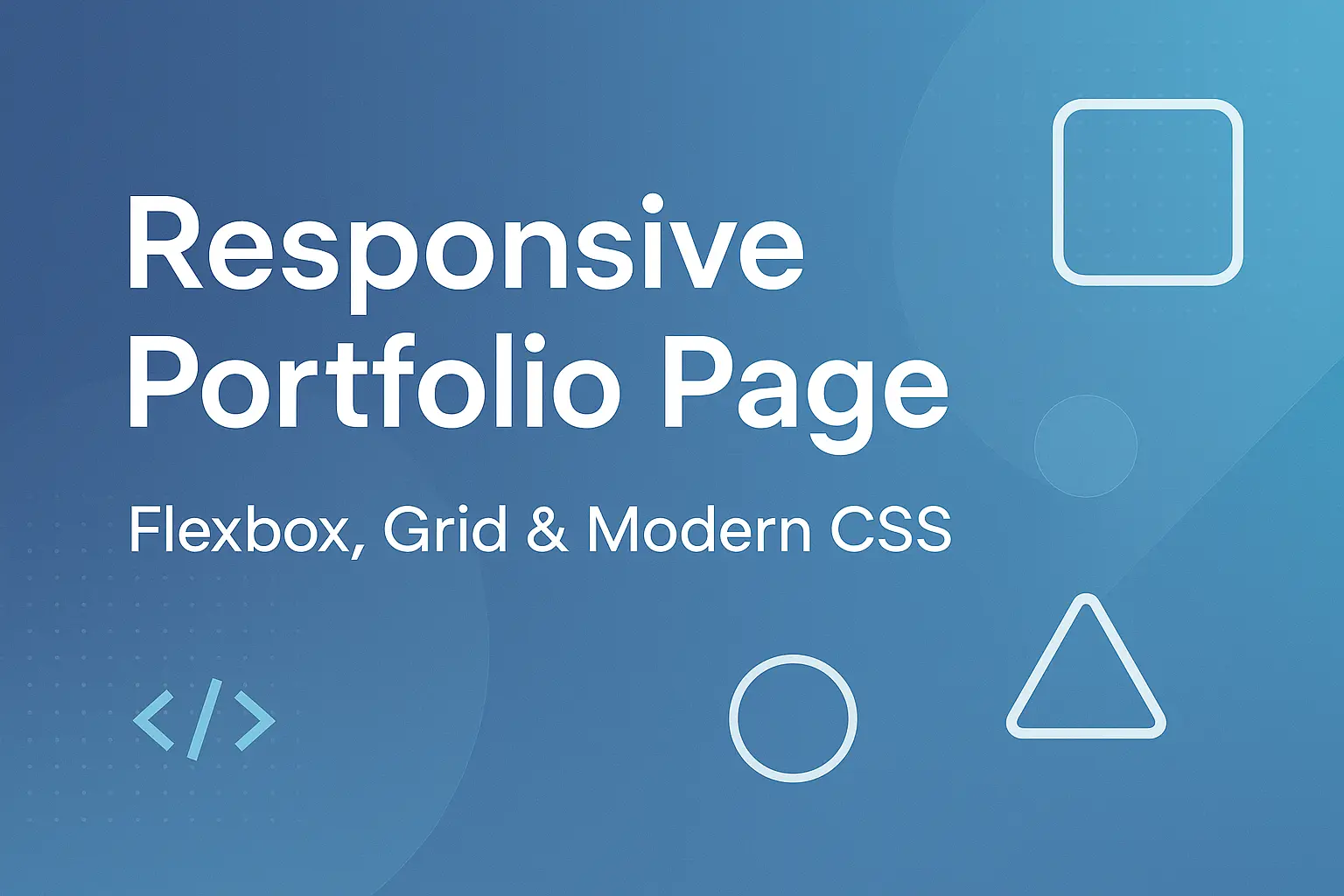Responsive Portfolio Page Project — Combining Flexbox, Grid & Modern CSS

Introduction
You’ve mastered the building blocks of layout and responsiveness.
Now, let’s bring them together in a real-world project — building a responsive portfolio page.
This project demonstrates:
A semantic HTML structure
Flexbox navigation and hero alignment
CSS Grid project gallery
Responsive scaling with
clamp()andminmax()Container-based adjustments
A clean, mobile-first design
By the end, you’ll have a working, modern layout ready for a real portfolio or resume site.
1. Project Overview
Goal:
Design a personal portfolio landing page that works across mobile, tablet, and desktop devices.
Sections:
Header + Navigation
Hero section with intro and image
Projects grid
Contact footer
Techniques Used:
Semantic HTML
Flexbox (nav, hero)
CSS Grid (project gallery)
clamp() for fluid typography
Media queries for layout adjustments
2. HTML Structure
<!DOCTYPE html>
<html lang="en">
<head>
<meta charset="UTF-8" />
<meta name="viewport" content="width=device-width, initial-scale=1.0" />
<title>Responsive Portfolio</title>
<link rel="stylesheet" href="styles.css" />
</head>
<body>
<header class="header">
<div class="logo">MyPortfolio</div>
<nav class="nav">
<a href="#">Home</a>
<a href="#">Projects</a>
<a href="#">About</a>
<a href="#">Contact</a>
</nav>
</header>
<section class="hero">
<div class="hero-content">
<h1>Hi, I'm Alex</h1>
<p>I build modern, responsive, and accessible web experiences.</p>
<a href="#" class="btn">View My Work</a>
</div>
<img src="portrait.jpg" alt="Developer portrait" class="hero-img" />
</section>
<section class="projects">
<h2>My Projects</h2>
<div class="grid">
<article class="project-card">Project 1</article>
<article class="project-card">Project 2</article>
<article class="project-card">Project 3</article>
<article class="project-card">Project 4</article>
</div>
</section>
<footer class="footer">
<p>© 2025 MyPortfolio. Built with ❤️ using HTML & CSS.</p>
</footer>
</body>
</html>3. CSS: Mobile-First Base Styles
* {
box-sizing: border-box;
margin: 0;
padding: 0;
}
body {
font-family: "Inter", Arial, sans-serif;
line-height: 1.6;
background: #f9fafc;
color: #222;
}
/* Header */
.header {
display: flex;
justify-content: space-between;
align-items: center;
padding: 1rem;
background: #fff;
border-bottom: 1px solid #eee;
}
.logo {
font-weight: 700;
font-size: 1.25rem;
}
.nav {
display: flex;
gap: 1rem;
}
.nav a {
color: #333;
text-decoration: none;
font-weight: 500;
}
.nav a:hover {
color: #0077ff;
}
/* Hero section */
.hero {
display: flex;
flex-direction: column;
align-items: center;
text-align: center;
padding: 2rem 1rem;
background: #fff;
}
.hero-content h1 {
font-size: clamp(1.8rem, 4vw + 1rem, 3rem);
margin-bottom: 1rem;
}
.hero-content p {
font-size: clamp(1rem, 2vw + 0.5rem, 1.25rem);
color: #555;
margin-bottom: 1.5rem;
}
.btn {
display: inline-block;
background: #0077ff;
color: #fff;
padding: 0.75rem 1.5rem;
border-radius: 5px;
text-decoration: none;
}
.btn:hover {
background: #3399ff;
}
/* Hero image */
.hero-img {
width: 100%;
max-width: 300px;
border-radius: 50%;
margin-top: 2rem;
}
/* Projects */
.projects {
padding: 2rem 1rem;
text-align: center;
}
.projects h2 {
font-size: clamp(1.5rem, 2vw + 1rem, 2rem);
margin-bottom: 1.5rem;
}
.grid {
display: grid;
gap: 1rem;
grid-template-columns: 1fr;
}
.project-card {
background: #fff;
padding: 1.5rem;
border-radius: 8px;
box-shadow: 0 2px 6px rgba(0,0,0,0.05);
}
/* Footer */
.footer {
text-align: center;
padding: 1.5rem;
background: #fff;
border-top: 1px solid #eee;
}4. CSS: Responsive Enhancements
/* Tablets */
@media (min-width: 768px) {
.hero {
flex-direction: row;
justify-content: space-around;
text-align: left;
}
.hero-content {
max-width: 50%;
}
.hero-img {
max-width: 250px;
margin: 0;
}
.grid {
grid-template-columns: repeat(2, 1fr);
}
}
/* Desktops */
@media (min-width: 1024px) {
.grid {
grid-template-columns: repeat(4, 1fr);
}
.hero {
padding: 4rem;
}
.hero-content h1 {
font-size: clamp(2rem, 2vw + 1rem, 3.5rem);
}
.projects {
padding: 4rem 2rem;
}
}5. Modern Enhancements with Clamp() and Minmax()
The page already uses clamp() for scalable typography.
You can further apply min() and max() for adaptive spacing:
.projects {
padding: min(5vw, 4rem);
}
.grid {
grid-template-columns: repeat(auto-fit, minmax(250px, 1fr));
}✅ Result:
The layout expands fluidly across all screen sizes
Projects reflow naturally without fixed breakpoints
Text scales smoothly for readability
6. Optional: Container Queries for Components
If you want each .project-card to respond to its own width:
.projects {
container-type: inline-size;
}
@container (min-width: 500px) {
.project-card {
display: flex;
align-items: center;
gap: 1rem;
}
}This makes each card adaptive inside grids or other containers.
7. Testing the Portfolio Layout
✅ Checklist:
Works on mobile, tablet, and desktop
No horizontal scrolling at small widths
Text scales smoothly
Buttons have adequate tap area
Images resize and maintain aspect ratio
Test on real devices or with DevTools’ device simulation.
✅ Summary & What’s Next
You’ve just built your first full responsive layout using:
Semantic HTML5
Flexbox & CSS Grid together
Fluid typography (
clamp())Responsive grids (
minmax(),auto-fit)Mobile-first design
You’re now ready for Phase 3: Styling Systems & Components, where we’ll move beyond structure into scalable styling patterns, reusable UI components, and CSS architecture.
Related
Design Systems & Component Libraries — TailwindCSS, CSS-in-JS & Scalable Frontend Architecture
Learn how to build scalable design systems and UI component libraries using TailwindCSS, CSS variables, and CSS-in-JS. Create reusable, consistent, and maintainable frontend foundations.
Performance Optimization for CSS & Frontend Rendering
Learn advanced CSS and frontend optimization techniques to enhance performance, improve rendering speed, and ensure smooth, fast user experiences.
Animations, Transitions & Microinteractions for Delightful UX
Learn how to use CSS animations, transitions, and microinteractions to create interactive, engaging, and intuitive frontend experiences that captivate users.
Comments